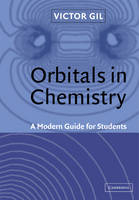
Orbitals in Chemistry
A Modern Guide for Students
Seiten
2000
Cambridge University Press (Verlag)
978-0-521-66649-7 (ISBN)
Cambridge University Press (Verlag)
978-0-521-66649-7 (ISBN)
A unified, up-to-date and mainly qualitative discussion of the role of atomic and molecular orbitals in chemistry. The relationships between the more formal quantum mechanical formalisms and the traditional chemical descriptions of chemical bonding are critically established. Includes over 100 exercises with solutions. Valuable to undergraduate chemistry students.
This text presents a unified and up-to-date discussion of the role of atomic and molecular orbitals in chemistry, from the quantum mechanical foundations to the recent developments and applications. The discussion is mainly qualitative, largely based on symmetry arguments. It is felt that a sound mastering of the concepts and qualitative interpretations is needed, especially when students are becoming more and more familiar with numerical calculations based on atomic and molecular orbitals. The text is mathematically less demanding than most traditional quantum chemistry books but still retains clarity and rigour. The physical insight is maximized and abundant illustrations are used. The relationships between the more formal quantum mechanical formalisms and the traditional chemical descriptions of chemical bonding are critically established. This book is of primary interest to undergraduate chemistry students and others taking courses of which chemistry is a significant part.
This text presents a unified and up-to-date discussion of the role of atomic and molecular orbitals in chemistry, from the quantum mechanical foundations to the recent developments and applications. The discussion is mainly qualitative, largely based on symmetry arguments. It is felt that a sound mastering of the concepts and qualitative interpretations is needed, especially when students are becoming more and more familiar with numerical calculations based on atomic and molecular orbitals. The text is mathematically less demanding than most traditional quantum chemistry books but still retains clarity and rigour. The physical insight is maximized and abundant illustrations are used. The relationships between the more formal quantum mechanical formalisms and the traditional chemical descriptions of chemical bonding are critically established. This book is of primary interest to undergraduate chemistry students and others taking courses of which chemistry is a significant part.
1. Energy, probability and electrons; 2. An introduction to the dynamics of microsystems; 3. One electron atoms: atomic orbitals; 4. The one electron molecule H2+: molecular orbitals; 5. Many electron atoms and the orbital concept; 6. Orbitals in diatomic molecules; 7. Orbitals in polyatomic molecules; 8. Molecular orbitals and electron pair bonding; 9. p Molecular orbitals: conjugation and resonance; 10. Patterns in localised chemical bonds; 11. The concept of molecular orbitals in other systems; 12. Orbitals in action.
| Erscheint lt. Verlag | 10.8.2000 |
|---|---|
| Zusatzinfo | Worked examples or Exercises; 127 Line drawings, unspecified |
| Verlagsort | Cambridge |
| Sprache | englisch |
| Maße | 174 x 246 mm |
| Gewicht | 614 g |
| Themenwelt | Naturwissenschaften ► Chemie ► Physikalische Chemie |
| Naturwissenschaften ► Physik / Astronomie | |
| ISBN-10 | 0-521-66649-X / 052166649X |
| ISBN-13 | 978-0-521-66649-7 / 9780521666497 |
| Zustand | Neuware |
| Haben Sie eine Frage zum Produkt? |
Mehr entdecken
aus dem Bereich
aus dem Bereich
Quantenmechanik | Spektroskopie | Statistische Thermodynamik
Buch | Softcover (2024)
De Gruyter (Verlag)
CHF 83,90
Set aus Lehrbuch und Arbeitsbuch
Buch | Hardcover (2022)
Wiley-VCH (Verlag)
CHF 149,95
Thermodynamik | Kinetik | Elektrochemie
Buch | Softcover (2024)
De Gruyter (Verlag)
CHF 83,90


